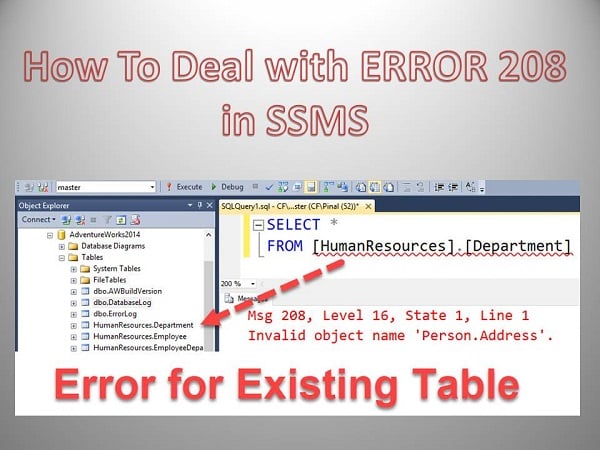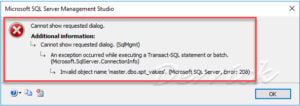In this article we explain about ERROR 208, why it occurs and how to deal with it.
We often come across situations which seem to be very complicated and challenging but are actually very easy to get out of; provided we think logically. One such situation a lot of SQL Server DBA’s come across is the SSMS error 208, i.e. the ‘Invalid Object Name’ error. This is a very commonly occurring error which ends up confusing a lot of DBAs. So today, we will not only provide you with a solution to this problem, but also suggest you ways to avoid it from occurring in future.
What is Error 208 in SSMS

What is most perplexing about this error to majority of DBAs is the fact that the object is visible to them in SSMS Object Explorer window but when they attempt to select it using T- SQL, they witness the error. This is the point where a lot of DBAs switch to extreme and desperate measures like restarting SSMS multiple times to furiously refreshing queries, restarting databases, etc. But to their sorrow, none of this will provide them with the solution they are looking for.
These practices fail to work because none of these is addressing the root cause of the error which is nothing but simple mismatch in database context.
How to Solve Error 208 in SSMS
Now that you know what is causing the error, finding the solution should not take long. The most common reason for this context mismatching error to occur is the fact that the default database context has been set to master. Well in 99 out of 100 cases, this ends up being the cause. And if this really is what is causing the error to appear in your system, then a very basic thing for you to do is changing the context of the database. And while you are at it, change it in a way that the context becomes similar to the current database object that is in use.
Once you perform this step, you will be glad to see that the error will appear no longer, and all other functions will also happen smoothly. This is one of those errors that almost every single DBA would have experienced, but few would actually know a way out of this situation without considering a repair sql action. This article would hopefully be of help to all of them. Apart from the solution given above, there is one more option that DBAs can try out; this involves prefixing multipart database name to the database that is in use. Or you might also want to change the database that opens by default once you login SSMS.
Author Introduction:
Victor Simon is a data recovery expert in DataNumen, Inc., which is the world leader in data recovery technologies, including corrupted mdb and sql recovery software products. For more information visit https://www.datanumen.com/